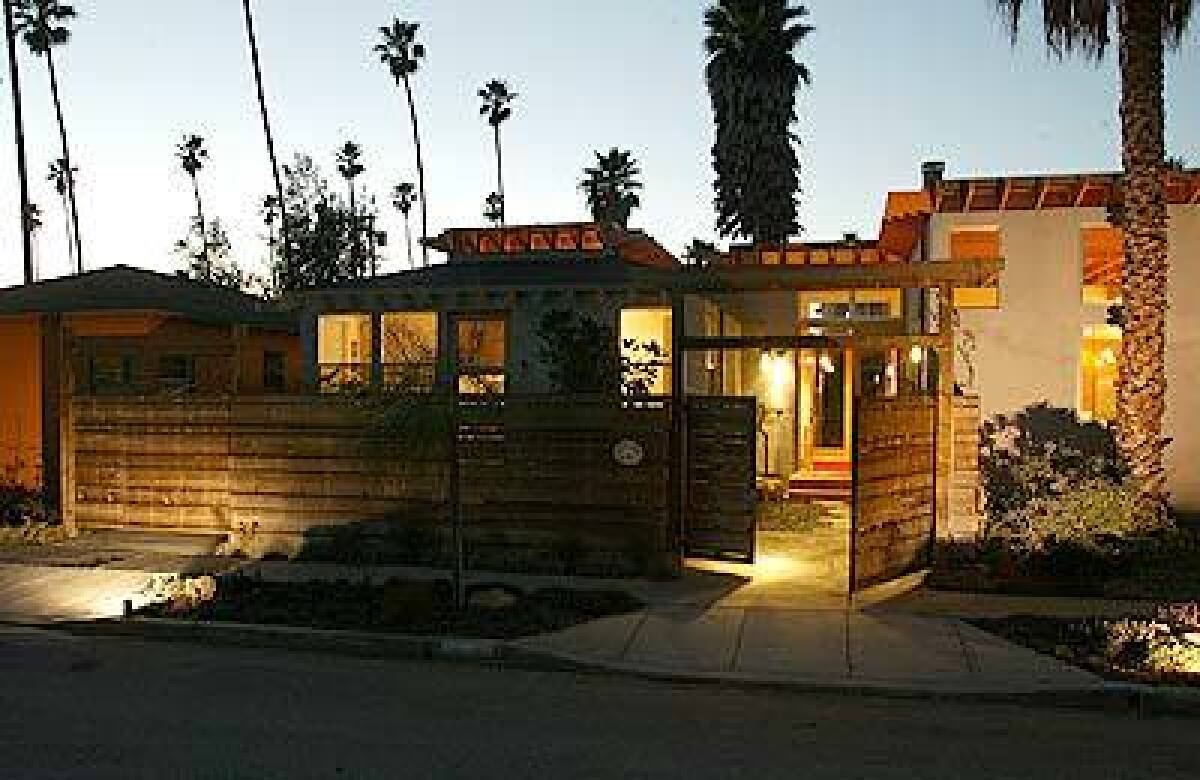Guided by height, light

Shafts of sunlight pierce the high windows and turn the Moroccan carpets a pulsating pomegranate red as Sharon Smith, a Canadian composer, sets out colorful platters of Mexican dishes and Fina Torres, a Venezuelan film director, brews strong lattes. A few of their friends are over for Sunday brunch, and everyone seems inordinately at ease in the casual setting, filled with flowers, books, CDs, original art, movie posters.
Even with its lack of pretense, Smith and Torres’ house comes as something of a surprise in this Venice neighborhood of unassuming beach bungalows. It looks, on the outside, like a stylized California version of Japanese shrine architecture — a postmodern pagoda, perhaps — with its burnt-orange roof, tapered rafter tails and torii temple gate that opens onto an entry rock garden.
FOR THE RECORDBungalow owner — In two photo captions accompanying an article about a remodeled Venice bungalow in Thursday’s Home section, owner Sharon Smith was misidentified as Susan Smith.
No less surprising is that it was once a 600-square-foot bungalow that was cleverly combined with a garage by Smith’s brother Garfield Smith, a sculptor whose only architectural experience had been in cabinetry and remodeling back in Toronto.
Peter Trias, the owner of a sushi bar on Abbot Kinney Boulevard, stands before an expanse of glass, watching the uncannily tall palm trees sway against a blue sky. His eyes are lured toward the roof, which floats above the house on a wraparound stretch of clerestory windows.
“Anyone who walks into the house looks up and goes ‘Wow,’ ” says Smith, smiling at her younger brother. “It was the completion of a dream I had with him.” She had wanted Garfield, who briefly studied architecture at the University of Toronto and who occasionally worked as a designer-builder, to create a studio where she could write music.
“But this was so much bigger,” Sharon Smith says. “I never thought we were going to build something of this scale.”
She gestures toward the sunken living room, where Garfield’s wife, Lisa Fischer, a Hollywood set decorator, has settled into a leather club chair the same shade of ruby as the scarf around her neck, and Ed Rothfarb, a chef turned art historian, sits on the ledge in front of the two-sided fireplace.
Hand-painted tiles, which Torres bought in Puebla, Mexico, and carried back in her suitcase, lean against the fireplace, ready to be glued into place. Slow-burning church candles on a shelf that’s part museum, part altar, illuminate a collection of miniature paintings made by Zapatista rebels.
Smith and Torres’ ardor for south-of-the-border culture and design has been amped by a recent trip to Mexico City, where Torres has an apartment. Today’s meal is not just any brunch, it’s a Frida Kahlo brunch, with stuffed chili peppers and chicken mole straight out of “Frida’s Fiestas,” the cookbook put together by the Mexican artist’s stepdaughter and known for its complicated recipes.
Smith leans over the cookbook and wrinkles her forehead. Though some guests mingle on the bamboo-lined pocket patios that seem to be everywhere, the others gather around the curved slate counter that separates the living and dining areas from the kitchen, where housekeeper Marina Ayala slaps dough between her palms as she prepares tortillas.
“We brought the mole negro back from Mexico,” Smith says, arranging the food on vibrant hand-painted Mexican platters while Torres perches on a bar stool, animatedly talking.
Smith had known Torres, the director of “Woman on Top,” only a short time when she began renovating the 1946 bungalow in 1999. But Torres’ gift to her of Tim Street-Porter’s book “Casa Mexicana” inspired Smith’s choice of materials, textures and colors, from the fossil-encrusted limestone vanities in the two bathrooms to the color of the roof.
In the beginning, though, Smith had no idea what she desired in a living space and environment. In fact, when her brother first asked her, she was at a loss for words.
“I knew I wanted a house that would be an expression of my sense of beauty and space,” Smith recalls, “but as a musician, I had no architectural vocabulary yet to describe what exactly that was. I kept saying, ‘I want something beautiful,’ and he kept saying, ‘Sharon, I need to know more than that.’ ”
Eventually the theme became “height and light,” two words that pretty much describe everything the original structures lacked. One thing the place did have going for it was its location on a southwestern corner in Venice, a lot soaked in sunlight filtered and dappled by big ficus and palms.
“I wanted to be as connected to the outdoors as I could,” Smith says. “As children, we summered in a wooden cottage on Georgian Bay in the Great Lakes where we lived half in the elements. I wanted that.”
There are echoes of that cottage’s wraparound porch in all those little patios and decks. The outdoor nooks and crannies also compensate for the 100 square feet of garden space that was eliminated when they joined two of the original structures, a 20-foot-by-30-foot bungalow and a converted three-car garage. (Another bungalow is now a rental unit but will eventually be converted into a music studio.)
“Getting outdoor space was a critical design factor,” explains Garfield Smith, “the idea of having small openings to the outdoors rather than one single yard.” To enhance the indoor-outdoor feel, all the doors in the house are glass and 8 feet tall; the bedroom and bathroom doors are sandblasted glass. Double glass doors lead to most of the outdoor spaces. “There’s an interpenetration of light everywhere,” Garfield Smith says. The dining room table is lighted from three sides and above.
The “height and light” motif is most stunningly articulated by the lifted roof, which brings the whole house together as a series of flowing living spaces and allows light to penetrate all the rooms.
The roof, which is constructed in two sections with exposed beams and rafters, incorporates more than 100 clerestory windows, each individually framed in steel. In addition to letting in tons of light, the clerestories are essential structural elements.
“The clerestories give the effect of lifting the ceiling,” Garfield Smith says. “The whole thing really floats.”
Nature and sunlight are further enticed indoors by four large windows, framed in anodized aluminum and strategically placed along the south living room wall to frame those tall, skinny Washington palms along the street.
“I call those palms my sentinels,” Sharon Smith says. “When they bend and sway, I think I’m in Africa.”
Her brother had never designed or built an entire house. Before coming to Los Angeles, he spent several months in Tokyo working on a sculpture commission — a 70-foot-long arc cast in bronze — for the Canadian Embassy there, and his stay inspired the house’s Asian design. Amazingly, except for the roof and the living room floor, he did all the building himself with the help of two workers.
The light construction of the original postwar beach cottages made the job less daunting. “Compared to the double-brick structures I was used to remodeling in the Northeast, this was easy to alter,” he says.
When he wasn’t working, he wandered the Venice streets and canals. “Venice is an intense little architectural environment,” he says. “It’s an off-the-grid community, dense with a host of artistic experimentation.”
At times, the architectural smorgasbord would spark his imagination and he’d run back to the drawing board and reimagine elements of the design. “We changed things as we went along,” Sharon Smith says. “It’s not all down on paper.”
The changes, though, sometimes led to altercations. “Because we were brother and sister, we’d have huge fights,” says Sharon, laughing. She financed the project and saw each design change in dollars and cents.
The biggest fight occurred when “I might have to take off part of the roof” became “I razed the roof.”
“When I got there, all that was left was the foundation and two walls,” Sharon Smith recalls.
That’s when she began asking herself some pretty existential questions. “I didn’t even know what having my own home meant,” she admits. She’d spent the past decade and a half living in other people’s houses or renting places that always felt temporary. “I didn’t know that I could envision something and make it come to be.”
Then a friend recommended philosopher Gaston Bachelard’s masterpiece, “The Poetics of Space: The Classic Look at How We Experience Intimate Places.”
“I read it the whole time I was doing the house,” Smith says. “Bachelard connects poetry to the space we live in. He talks about our instincts to nest and discusses the inner self and our expression of it. That book kept me going because, at times, it was a really difficult process.”
One that fortunately lasted only from October 1999 to March 2000, during which she worked as a music editor on “The Princess Diaries” — the film, she says, “that paid for the house.”
To get the maximum bang for their bling — which felt as if it was going out as fast as it was coming in — the Smiths chose unusual materials to make striking style statements, yet shopped around for reasonable suppliers.
Because putting down wood floors throughout the house would have cost a fortune, they used wood — American cherry — in only the living room. Though the dining room flooring cost less than wood, it’s actually much more dramatic; the honed soapstone, which looks like anthracite-colored slate, was also used in a larger format for the kitchen counters and backsplash.
The stone theme extends to the dining room table, which Garfield Smith designed out of Brazilian slate he found at Bourget Bros.’ “boneyard” in Santa Monica. He paid $200 for the more than 6-foot-long slab, which, were it not nicked on a corner, would have cost 10 times that.
For the bedroom floors, the Smiths chose Portuguese cork for its warmth and texture. The bathrooms are tiled in slate; each tile is unique and multihued from a palette that extends from lilac to dark gray. The vanity tops are fossilized limestone.
Despite the bold design choices, the 1,350-square-foot house remains surprisingly modest, with its average-size rooms and tiny patios and decks. By doing a lot of the work themselves and shopping around, it came in at about $125 per square foot. In the neighborhood, building costs range from $100 to $300 per square foot.
Garfield Smith had several other design jobs lined up before he even finished this one; people would drive by and ask for his card. He never moved back to Toronto; last year he married Fischer. They too live in Venice, just a few blocks from his sister and Torres.
And Sharon Smith finally discovered the meaning of home — getting everything she didn’t know she wanted in the bargain.
“This house has given me a sense of endless possibilities,” she says. “It’s like living in a sculpture. It lifts my spirit every time I come home.”
*
(Begin Text of Infobox)
Affordable elements
Sharon Smith and her brother, Garfield, looked for unusual but reasonably priced materials when they revamped a Venice bungalow. Among the elements:
Honed soapstone tiles, for the dining room floor, kitchen counters and backsplash (in 12-, 18- and 24-inch squares), Tropical Marble & Granite, 1431 Colorado Ave., Santa Monica, (310) 451-0838, https://www.tileemporium.com .
Bathroom tiles, desert light and desert lilac styles, Discount Tile Center, 8627 Venice Blvd., Los Angeles, (310) 202-1915.
Vanity tops, fossilized limestone, Bourget Bros., 1636 11th St., Santa Monica, (310) 450-6556, https://www.bourgetbros.com .
Brazilian slate, for dining room table, Bourget Bros.’ “boneyard.”
Cork flooring, for bedroom floors (12-inch squares, one-half inch thick), Linoleum City, 5657 Santa Monica Blvd., Hollywood, (323) 469-0063.
Douglas fir, bedroom and kitchen cabinets, Anderson Plywood, 4020 Sepulveda Blvd., Culver City, (310) 397-8229, https://www.andersonplywood.com .
Glass doors, prehung and used throughout house, Stock Building Supply (formerly Terry Lumber), 3860 Grandview Blvd., Mar Vista, (310) 881-2001, https://www.terrylumber.com .
Mexican river rocks, rock garden (1- to 2-inch), Balboa Brick & Supply Co., 16841 Roscoe Blvd., Van Nuys, (818) 785-7492, https://www.balboabrick.com .
— Andréa R. Vaucher


